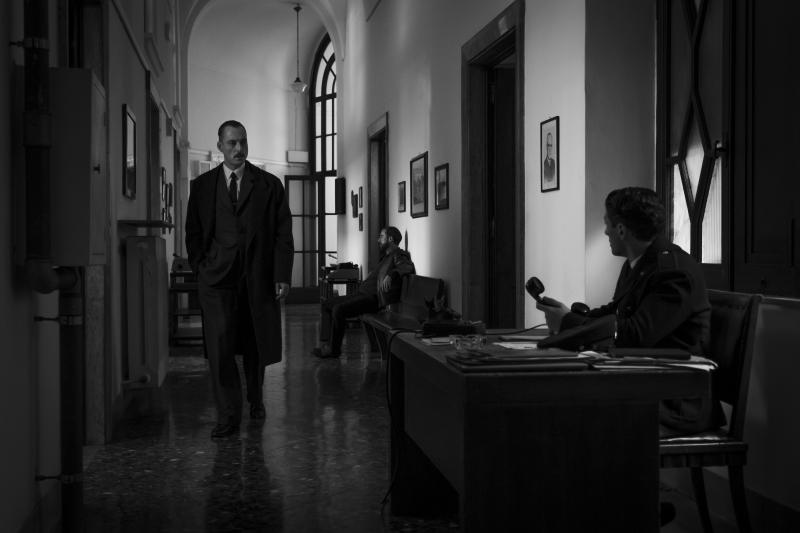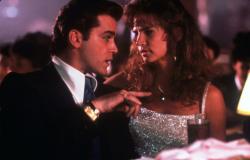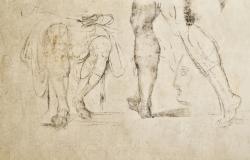The trailer for the new Netflix series Ripley begins with a man walking down a damp street under a train overpass. The scene, in black and white, evokes intrigue, mystery, classic noir cinema. It’s a far cry from the 1990 film The Talented Mr. Ripley that most might already know, the story of conman Tom Ripley based on Patricia Highsmith’s novel of the same name.
In the film, the psychological manipulations of Tom Ripley play out against the Mediterranean light of the Amalfi Coast, a playground for young, rich Americans escaping 1950s America. The fictional town of Mongibello is where Tom (Matt Damon) falls for the allure of the world of Dickie Greenleaf (Jude Law), the subject of his conning, then affection and later manipulation. He follows Dickie to glitzy hotels, sexy jazz clubs, and opulent mansions around Italy, a stark contrast to the grisly events that follow.
But Ripley, the series, ignores these depictions of an Italy bathed in buttery-soft colors and a folkloristic culture. Written and directed by Steven Zaillian, the series is nonetheless gorgeous in monochrome, removing the glittering veneer to reveal the sinister undertones, Tom’s diabolical machinations.
Maurizio Lombardi, one of the only Italians in Ripley’s main cast, plays Pietro Ravini, the inspector tasked with investigating the trail of murders Tom leaves behind as he chases another life. In the film, the inspector appears for a brief moment before being removed from the case for incompetence. Maurizio’s Ravini is a much more complex representation of the character — a vestige of hardboiled police inspectors, he explains — just as the series itself is a deeper exploration of the story of Tom Ripley.
This interview has been edited for length and clarity.
Maurizio Lombardi on remaking an iconic film
Alexa Ahern: Before signing on to Ripley, had you read the book or seen the previous films that had been made based on it?
Maurizio Lombardi: No, I had not read the book before the series. The first time I met the Ripley character was when I watched the movie, The Talented Mr. Ripley. After, I read the book, and then I met Steven Zaillian for the casting. But for me, the screenplay is better than the book. Patricia Highsmith is an amazing writer, but I think the screenplay is better and more clear about the personality of Tom Ripley.
AA: Can you tell us about your character? Is it a new character? Who is he?
ML: This is one of the reasons I said the screenplay is better than the book because Patricia Highsmith at the end of the book makes a bit of a mess. There’s Pietro Ravini, Roverini and inspectors from the United States, but Steve deletes all the inspectors except one [composite character], Pietro Ravini. Because Pietro Ravini exists in the book, but then Patricia Highsmith writes about Pietro Roverini and then other inspectors from the United States, too. So, Pietro Ravini in the screenplay is a new character, and in the book, he’s the third inspector.
AA: How is Pietro Ravini different from the depictions of the inspectors in the film or book?
ML: In the series, Pietro Ravini is the classic character from the 1950s: the mustache, the hair slicked back, the cigarettes. [He’s] a very elegant gentleman, like in hardboiled, Raymond Chandler novels, Robert Mitchum, Jack Nicholson in Chinatown. So, we have a classic character, the hardboiled style. The book by Patricia Highsmith is not like this.
AA: So this is where you drew inspiration for your character?
ML: For my preparation, I drew inspiration for my character from the photograph of the gentlemen of Milano in the late ‘50s and early ‘40s in the bar, a classic bar in Milan. I found very beautiful photographs of this. Second, I built my character with Steve Zaillian, the director, because the series is full of particular props — ashtrays, cigarettes, sofas — so I got to play with these props.
AA: This series is in black and white, which is very different from the aesthetic of the film. Does this mean that the series will be more sinister and dark? Does it bring out those aspects of the story more?
ML: The black and white is very precise and strong, like a graphic novel. The characters grew up with black and white because when you don’t have distractions with a lot of color, the audience can concentrate on the lines. You can completely understand more than in classic color cinema. It’s clearer than a color image. The soul of the characters emerges more clearly, especially with Tom Ripley.
AA: In the film, one of the stereotypes of Italy presented is poking fun at the judicial system. Does the series treat this differently? Were there conversations during production about how you were representing Italy and Italians?
ML: The director did such a nice job that even Italians can see and discover an Italy of the past that has now disappeared. It is not the classic way that maybe Americans have of depicting our country. It is a homage to an Italy that hasn’t been done in a while by a master, almost neorealism. He almost seems like a master of neorealism.
AA: For example?
ML: He used the silence of objects to present moments of high tension. One object in particular is the choice of ashtrays.
AA: For your character, did you discuss with the director how to depict him without falling into these stereotypes?
ML: I believe Steve loves noir, and he loves the character of the police inspector. You know The Night Of by Steve Zaillian with John Turturro? In this series, we have Box, the inspector, so tough, so silent. He’s a beautiful character. Steve had a love for the inspector. And my lines and my script were so beautiful to read.
AA: What episode do you first appear in?
ML: In the sixth episode. When he discovers the body on the Via Appia Antica, arriving in a Lancia car. Beautiful.
AA: What locations did you film in and did you have a favorite place?
ML: I was shooting in Rome at Cinecittà of course. We recreated Tom Ripley’s apartment in Rome at Cinecittà. A bit in Venice, Palermo, Napoli. Yes, Cinecittà! It’s the city of dreams. I love my country, Venice, Palermo and Napoli, but Cinecittà is… it’s not fake, it’s a dream. Where dreams are. Italy is like a little gift. If you go to a Tiffany store, Italy is a diamond.
AA: How was working in English and how was this series different from other mixed language projects you have worked on, like The New Pope?
ML: For me, playing in English is better. I don’t speak very well when I speak for an interview. I speak good English when I memorize all my lines. The particularity of the English language is that it’s so fast, it’s so easy to play in English. For me it’s better. I love playing in English. I love the accent, the sound. In this series, I had the biggest challenge of all my life, my career, on an English project, because in front of Andrew Scott, a mother-tongue English speaker, I had such a long shot, 20 minutes in English. It was a big challenge.
AA: Do you find it easier or harder to embody a character when you are speaking a language that is not your own?
ML: No, it depends. I love playing in different languages, because in another language you can forget the images that words bring up [in your own tongue] and focus on the body. When you act, you don’t think a lot, you just have to do it.
AA: If you could take on the life of someone else (or play anyone)… obviously without the murder, who would you like to be?
ML: Gianni Agnelli. He’s one of my favorite figures in Italy. Charming, elegant, great personality. He’s a giant. I would like to both play him in a film and take on his personality.
Ripley is now streaming on Netflix.



















